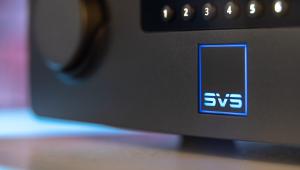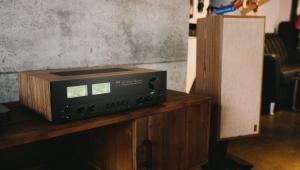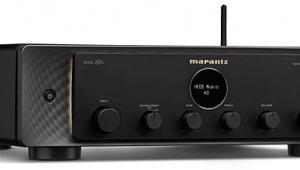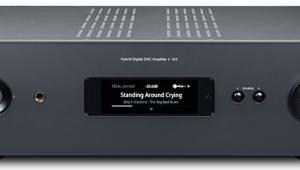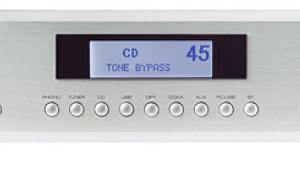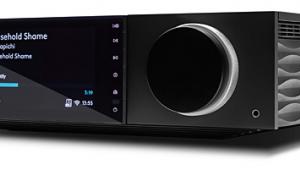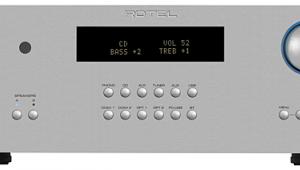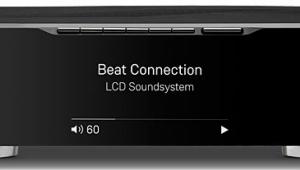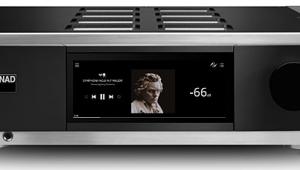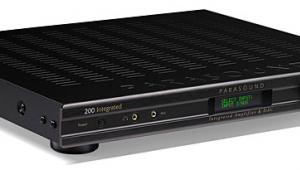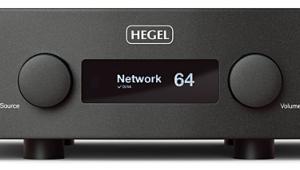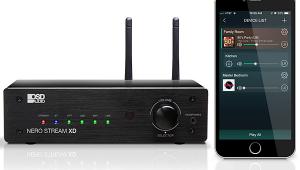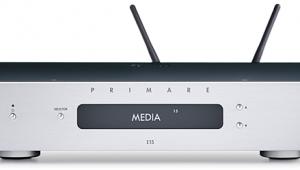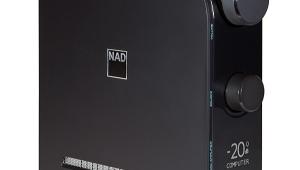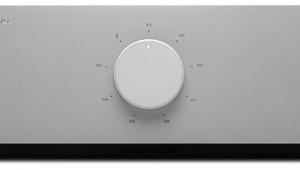Wadia Digital Intuition 01 Integrated Amplifier-DAC
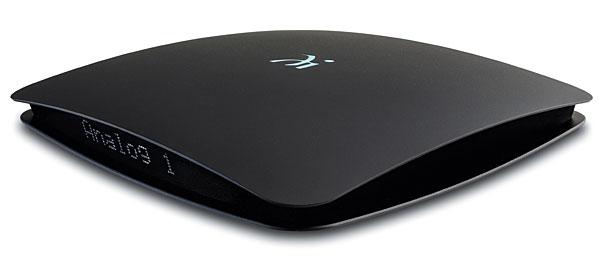
AT A GLANCE
Plus
Superb sonics from high-resolution digital sources
Substantial amplifier power
Unusual looks; fine finish quality
Minus
No headphone or other additional outputs
Un-ergonomic remote controller
THE VERDICT
Reference-quality sound from hi-rez music files made
simple—at a reference-grade price.
What form will the Audiophile System of the Future take? It’s an open question, though it’s a pretty fair bet that the pallet-loads of tube power amps and skyscraper speakers of the high end’s golden age will not return any time soon. One proposed answer, from Wadia Digital, is the Intuition 01 power DAC, a swoopily formed oblong that incorporates very substantial two-channel amplification (190 watts x 2 into 8 ohms, rated), highly sophisticated digital-to-analog conversion facilities, and basic input-selection and volume controls.
Wadia’s current corporate incarnation is as a member of the Fine Sounds Group, owned in turn by an Italian private equity firm that in recent years has amalgamated high-end U.S. brands Sumiko, McIntosh, and Audio Research, along with Italian speaker-maker Sonus Faber. But the Wadia name is no stranger to high-end digital. Its late-’80s origins produced one of the first outboard DACs to make audiophile digital audio acceptable as a non-oxymoron.
Visually, the Intuition 01 irresistibly suggests a shy quahog, or perhaps a melting ice-cream sandwich. Fit and finish look and feel truly expensive, as well they might. Functionally, the Wadia is essentially a sophisticated integrated amplifier; you need only connect a suitable pair of loudspeakers and your audio sources to complete a very serious two-channel system. In this, the Intuition 01 mirrors the NAD D 3020, though the Wadia is much more powerful and has rather more input flexibility—and costs 20 times as much.
The Intuition 01’s digital inputs include one TosLink optical, two coaxial digital (RCA jacks), a pro-audio standard AES/EBU digital input (XLR jack), and an asynchronous USB port. There are also two HDMI connectors, but these do not accept signals from HDMI sources like Blu-ray players (the Intuition 01 has no video functions whatsoever). Instead, labeled Wadia-link1 and 2, these employ HDMI physical jacks for I2S-LVDS inputs. This bleeding-edge digital interface, borrowed from the world of computer internal-component interfacing, is viewed by Wadia as the lowest-jitter solution to date (among other things, I2S-LVDS fully isolates clock and audio data). So far, I2S-LVDS is mostly found among solder-sniffing DIY-digital audiophiles; PS Audio is one of a few other high-end brands currently implementing it. The Intuition 01 also provides two stereo analog inputs, which are treated with 32-bit oversampling analog-to-digital conversion.

In the Digital Music Future, digital files, especially high-resolution music files, will be the serious listener’s source of choice. Regardless of how those files are served to the Wadia—and the source component, or at least its connection, may matter quite a bit in terms of sonics—the Intuition 01 has no part in the music’s human interface, functioning simply as the B-chain. You could, of course, simply plug in a CD or SACD player, but the Wadia seems to me clearly meant to be helmed by a computer or memory-based music source of some sort, be it Mac or PC, desktop, laptop, or (God forbid) handheld.
Setup
I went with my studio/office’s iMac because that’s where my music lives; this required nothing more than stringing a long USB cable from the computer to the Wadia. Otherwise, for one who’s labored for decades over A/V receivers and other such complications, setting up a unit like the Intuition 01 is gratifyingly simple: four banana plugs from my main stereo speakers (Energy Veritas 2.2); the aforementioned USB cable from the iMac; done. No menus; no calibration routines; no modes, preferences, or settings; life is good.
The USB hookup is preferred because it allows the destination component—in this case, the Wadia—to become the digital traffic cop, directing the source (the iMac) to stream out digital words in response to the Wadia’s clock rather than to its own. Usually, this yields a much lower jitter component. (This requires an asynchronous USB port, which feature the Intuition 01 shares with most every other outboard DAC with any audiophile pretensions. An I2S connection might yield lower jitter still, but I didn’t have a I2S source or bridge on hand.) Jitter is judged by many serious digital-audio thinkers to be the last barrier to genuinely bit-perfect playback: Time-domain errors (jitter) are thought by some to transcode to digital-data errors in ways, they believe, that cannot be detected by error correction.
With my computer source connected, all that remained was software to serve up the music files. The ubiquitous iTunes is the most usual choice, but Apple’s music manager still does not accept high-rez formats other than Apple Lossless. Fortunately, there are several alternatives in both Mac and PC worlds. I used several applications, including JRiver’s Media Manager for DSD files.
Listening
However it receives its music programming, most of us would expect a $7,500 integrated amp to sound pretty damned good, so few of us should be surprised to hear that the Intuition 01, in fact, did. Real good. Real, real good. And if that’s all you need to know, feel free to skip to the end.


